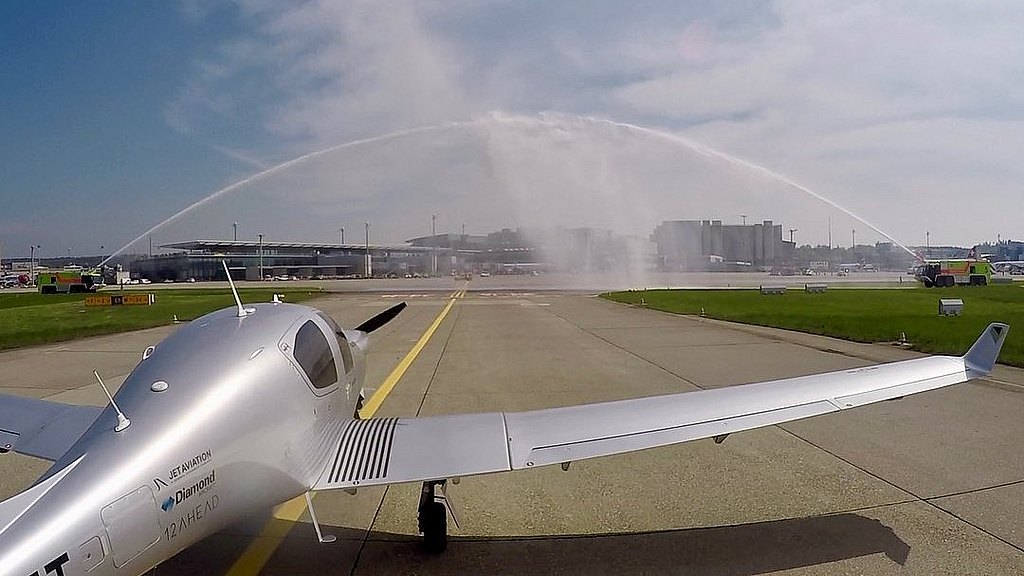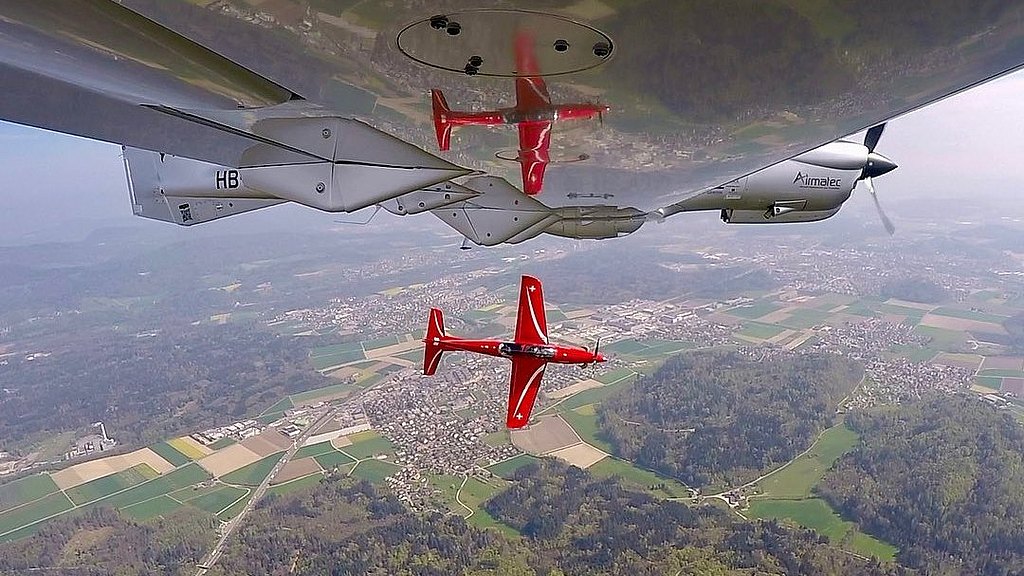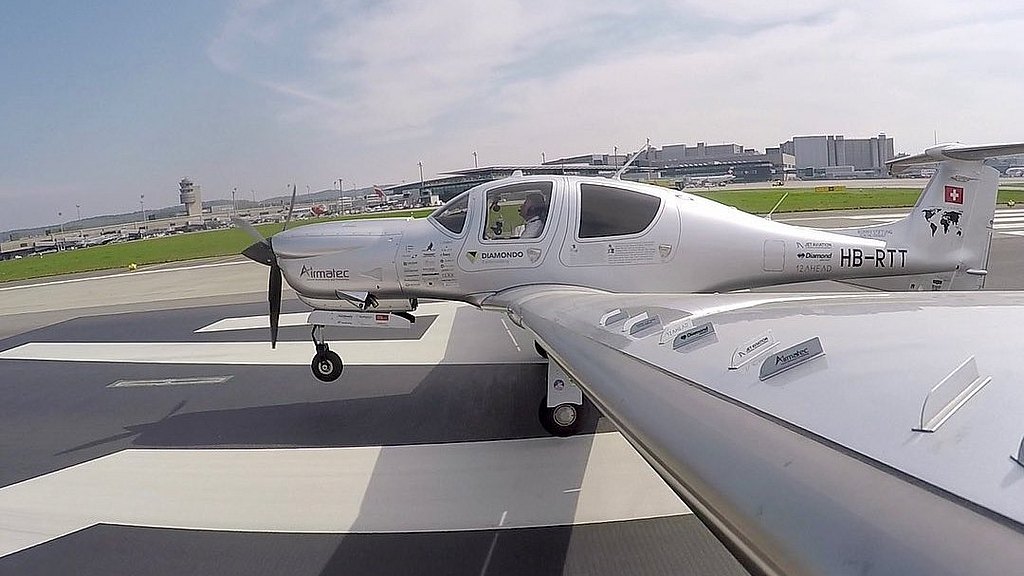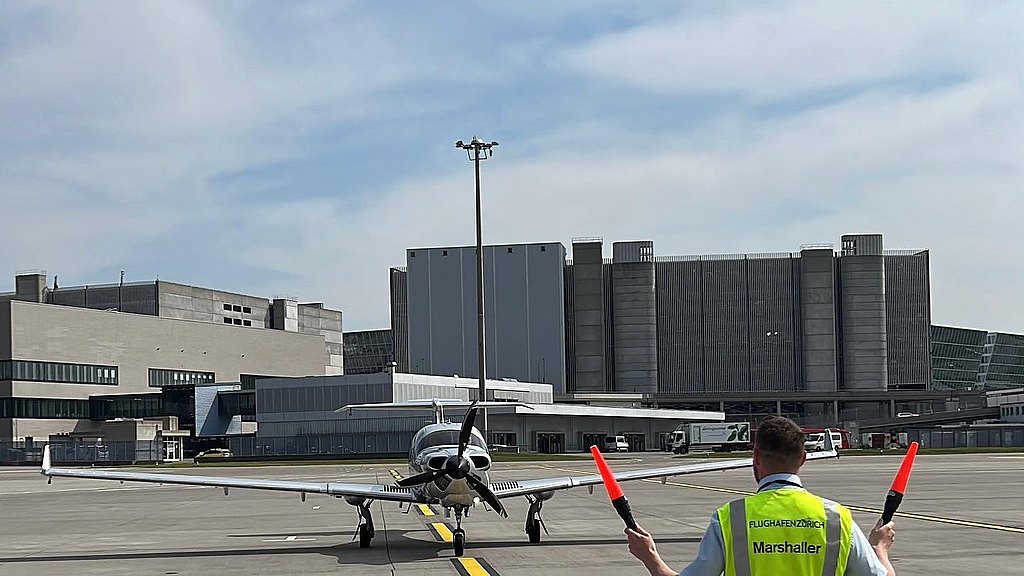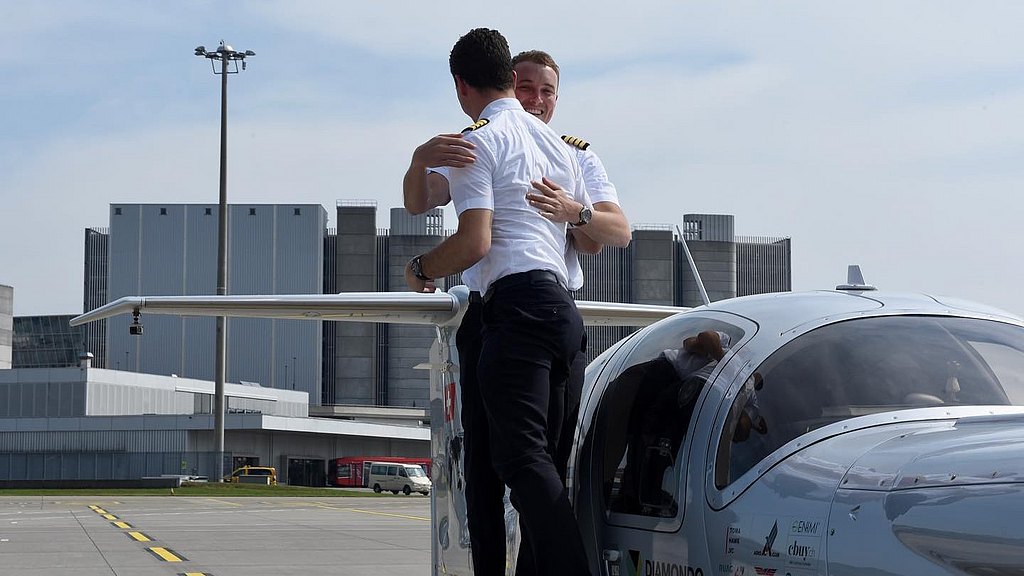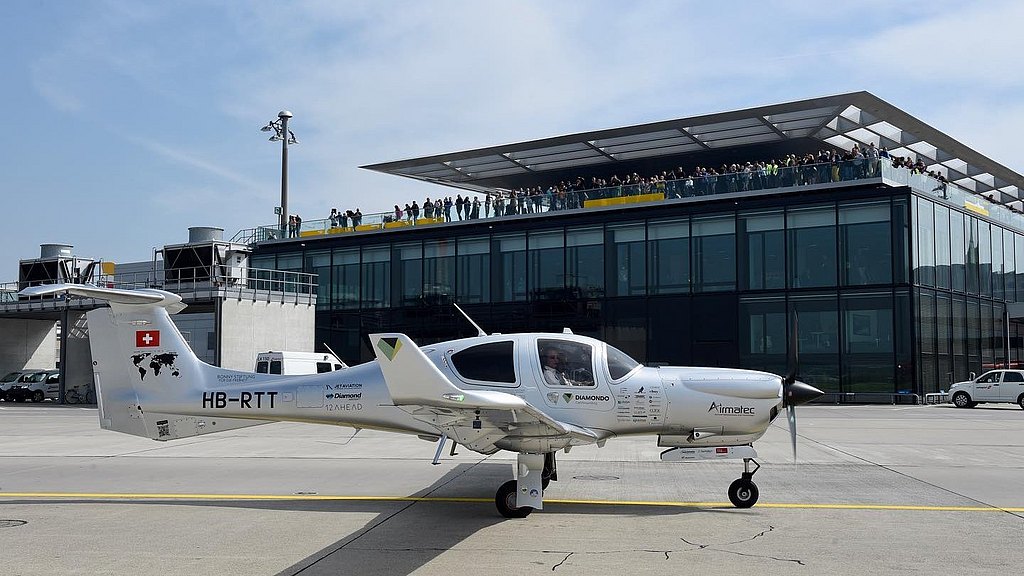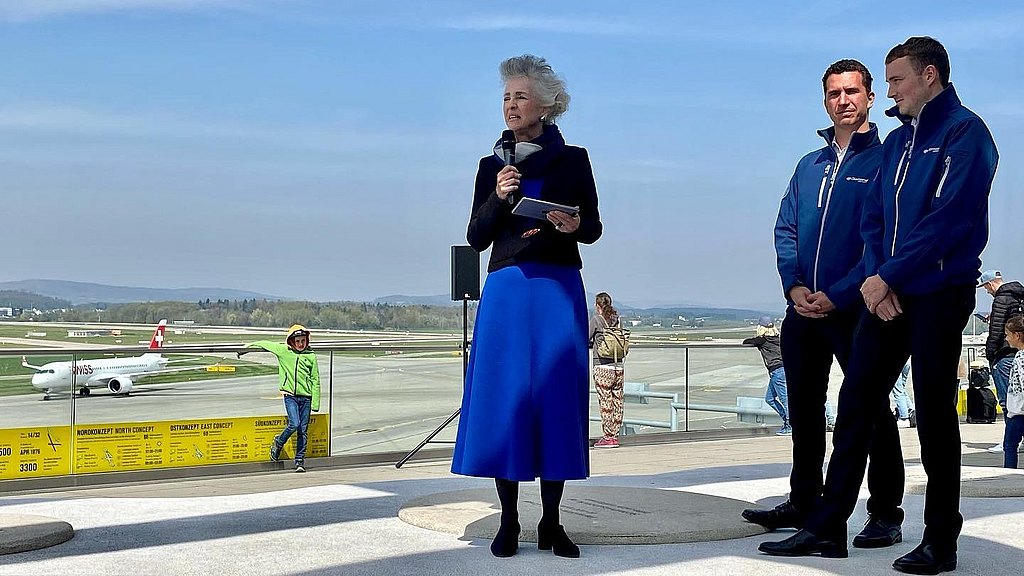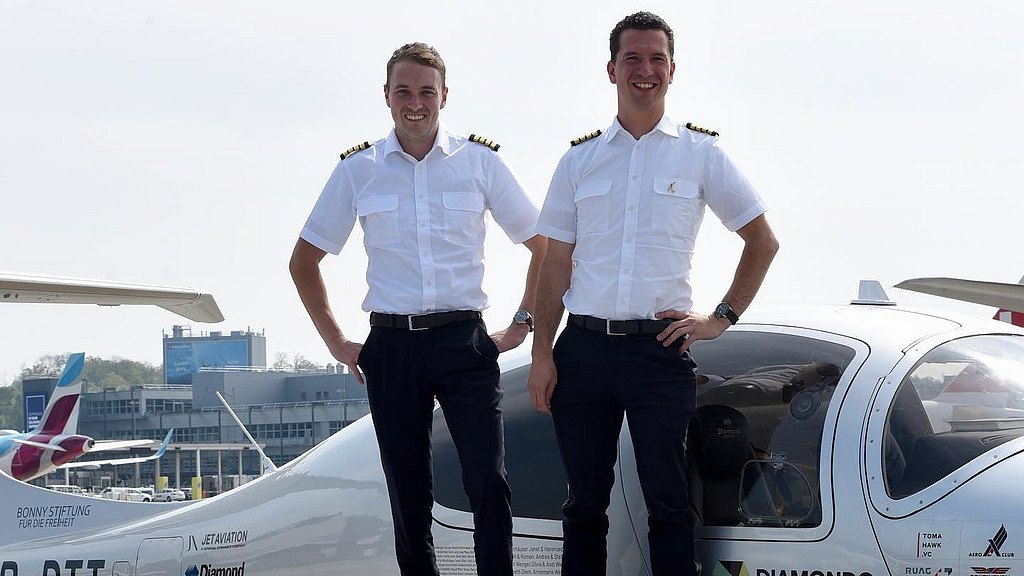Our highlights
When being on the road for 111 days, there are countless highlights. From a flying perspective it was definitely the island-hopping experience in Hawaii, the challenging landing in St. Barts and the breathtaking sights of Greenland, just to name a few.
However, Diamondo Earthrounding is more than just the flying part. It was amazing to see the vastness of the Al Maktoum Solar Park in Dubai and to learn about the technology behind it. Getting to meet the farmers of Nicaragua that participate in the community reforestation project supported by MyClimate was very emotional, since it’s not only important for our climate, the additional money earned by the project gives the farmers a much required additional source of income.
One of the best things definitely was working with such an enthusiastic and driven young team of experts with a great passion for aviation. All nine members are under 30. Whereas we are certainly not the youngest pilots accomplishing such a project, I am pretty sure we are the youngest team that pulled something like this off.
Last but not least, and especially for Matt, being able to give loved ones living on another continent a hug after quite some time, also due to the pandemic, shows the true value of aviation in a globalized world as it can connect societies and people face-to-face.
Now that was a long leg
When planning to cross the Pacific - the largest body of water on our planet - with a small aircraft, it comes down to three possible routes: North, Central and South. The Northern route presents the shortest time over water, using the Bering Street between Alaska and Russia. This variant was ruled out quite quickly since we planned to do the crossing in February and the weather at that time of the year is just not suitable for small aircraft.
Soon, our planning focused on the Southern route that would lead us from Australia eastbound via Fiji, Cook Islands, Tahiti, Easter Island and finally Chile. However, due to Covid regulations still in place, we were not allowed to enter Australia, which was crucial to perform to comply with the 100h scheduled maintenance inspections. So, we ended up choosing the last option, the Central route. It leads through Hawaii, from where one has to cover more than 2000 nautical miles to reach the shoreline of California. We knew that it was possible for us to fly the leg to California, but the question was, how do we get to Hawaii? We considered the US island of Guam as a given since we knew that liberal Covid regulations in US territories would allow us to enter. However, Guam-Honolulu is more than 3,300 nautical miles and therefore far too long for a non-stop flight in a DA50 RG, even with the ferry tank modification. We discussed several options of what stopover point to take in between. Unfortunately, we failed to obtain a landing permit on Wake Island (US Air Force base) and Tarawa, Kiribati (also due to Covid restrictions). Our final straw was Majuro on the Marshall Islands. Through a diplomatic note by the Swiss embassy in the Philippines to the officials of the Marshall Islands we were finally granted a landing permit on Majuro. What a relief!
However, there was a fly in the ointment: Again, due to Covid, we were not allowed to enter the country located on an atoll and had to limit ourselves to a technical stop. This meant the weather had to be right for both of the two very long consecutive flights. When the chosen date of the flight (9th of February 2022) arrived, we got up after a couple of hours of sleep at 11pm and made our way to the Guam International airport. After preflighting the aircraft in pouring rain, we were ready to depart at 2am and were vectored out of the cells by Guam ATC, headed out into the vast darkness of the Pacific Ocean. Although this leg was “only” about 1,600 nautical miles long, we were experiencing a nasty headwind all the way, which resulted in a flight time of 12 hours. For our Pacific itinerary, we were always under the watchful eye of Swiss International Air Lines’ mission support team. The mission support agent was able to communicate with us through our built-in Garmin Connext satellite phone, informing us on any emerging weather trends or change in wind components. We arrived in Majuro late in the afternoon, just to be greeted by another tropical rain shower. After waiting for the rain to stop and refueling the aircraft, we were able to lay down for another couple of hours until the planned departure time of midnight Marshall time (UTC+12) arrived. We got in the aircraft, but didn’t talk much apart from the necessary, likely as both of us felt the tension of conducting the following flight. In order to evade the easterly trade winds, our flight planning team member David had proposed a route that would take us north of the great circle track. However, this meant that the actual distance to be flown was 150 nautical miles longer, totaling at more than 2,100 nautical miles.
Inflight, and approx. every hour, we were transferring fuel from the ferry to the main fuel tank. A process lasting roughly 20 minutes after which we made sure the fuel indications matched our calculations. Especially during the early morning hours, we took turns napping. After crossing the international date line, we witnessed the second sunrise on this same date and were thankful when finally the Hawaiian island of Kaua’i came to sight. The DA50 RG touched down at Honolulu International Airport after 13 hours and 18 minutes of non-stop flight. Tired but happy we received our traditional Lei flower chains. What an experience!
Our experience with the aircraft and the engine
We must confess we were skeptical of how well such a young airframe and relatively young engine design would behave in a real-world operational scenario, especially as we were planning to fly through different climate conditions and consuming different grades of jet fuel along our route. To have a proper benchline, the aircraft underwent its first 100h inspection at 50h Time in Service and prior to departure at our Diamond Service Center Airmatec in Switzerland. The Airmatec Crew reconfirmed our seamless experiences flying the DA50 RG for 50h as no squawks had to be fixed. We then used the initial flight hours of our trip towards Thailand, mostly over land, to gain further experiences and conducted another 100h inspection at Aviation Aerospace Services, an authorized Diamond Aircraft Service Center, in Bangkok. After the inspection we were confident that from a mechanical perspective, nothing was standing in the way of taking the plane over the Pacific waters. Obviously, concluding the Pacific crossing by touching down in Monterey, California with no strange indications or vibrations from the engine, was reassuring that we operate on reliable equipment. The only real defect we faced was a failure of the Pitot Heat which was taken care off before setting out over the Atlantic.
Apart from the low fuel burn, we appreciated the ease of operating the Continental CD-300 engine with the single lever control. We never had to worry about shock-cooling cylinders or adjust our climb profile to bring down high CHT (Cylinder Head Temperature), which especially in unfamiliar terrain and interesting weather conditions was a burden taken from our shoulders. Also being able to just start the engine without having to worry about special engine starting procedures to factor in e.g. cold conditions in Canada’s North or High elevation effects, such as in Mexico City, further facilitated our operations. We also enjoyed observing the mechanics' grins whenever they took off the engine cowling and saw the CD-300 installed to the DA50 RG.
We also were asked about why the DA50 RG is compared to an SUV. After being able to use an SUV to bring all our luggage to the airport for our departure and loading it into the aircraft, we discovered that it was actually easier to load our belongings into the DA50 RG than it was to load it into the car. So, we deem the SUV comparison a valid one. Apart from the spacious cabin, the handling of the aircraft is straightforward. This also expands to energy management when flying approaches. You hardly find yourself in a position from where you could not transition from a high energy approach into a safe landing. And if you have to aim for a short landing, one will find that the stability of the aircraft will support the pilot greatly during such procedures.
Apart from gaining further confidence in both engine and airframe by operating them, we are also aware of which safety features are incorporated in the DA50 by design. Through visits at Diamond Aircraft in Wiener Neustadt during the production of the DA50 RG, we were able to observe first-handedly how e.g. the shock absorbing membrane is placed below each of the seats or how the aluminum fuel tanks are tucked away safely between the robust wing spars. Once we conducted the Factory Flight Training on the type, we were amazed at how well the aircraft glides. Fair to say that the excellent glide performance in combination with the many design features aimed to increase the safety of the occupants convinced us to depart on our journey in a SEP - and without us missing a parachute. ;)
Would we do it again?
We were often asked why we planned the trip in Northern winter time, why we took such a young aircraft for this endeavor or why we took this exact route. In hindsight we have to say that all those decisions were justified. The weather was playing along, the aircraft performed meticulously well, and the route worked also in times of the Omicron variant. So, in general, we would not change much if we were again at the same point roughly in 2018 and just decided to actually do this.
Of course, there are also things to learn. For example, we would plan for more technical stops instead of overnights. Just to get out or back into the airport can easily take up to two hours in certain parts of the world. If we were to do it again, we could likely adjust our route to include even more of those airports already offering physical Sustainable Aviation Fuel (SAF) as the number of airports is constantly growing.
What we learned about sustainable aviation
There is a lot of talk about the topic, especially within the professional aviation industry. There are also quite some myths surrounding it, but bottom-line we feel there is insufficient tangible action done to support existing GA fleets to fly more sustainably. With our emission calculator, we try to start the discussion by helping pilots to assess their emissions when flying and offering them a way to offset them by investing into projects, some of which we as Diamondo Earthrounding have visited on our journey. Apart from confirming their usefulness to address local climate change, we also value their results regarding social development of the respective area. Especially in Nicaragua they indirectly helped to address local poverty.
With Sustainable Aviation Fuel (SAF) blended jet fuel, we also have an option to effectively reduce emissions. SAF’s physical availability however is still very limited. On the one hand, there currently is a relatively small number of production facilities worldwide and the fact that SAF loses much of its emission reducing potential if carbon intensive transportation is required to deliver it from the production plant to an airport favors its use close to the production plant. We therefore were happy to partner with Jet Aviation, which through their “Book & Claim” services made sure that whenever we fueled fossil jet fuel, the same amount of SAF was uplifted into aircraft departing Amsterdam Schiphol. Such virtual schemes allowing SAF to be available regardless of the physical location of an operator will be essential in defossilizing aviation fuels. Through these schemes, we as a community of jet fuel capable aircraft operators can push the demand for SAF bottom-up, helping to scale production facilities and bringing the price premium of SAF down further. However, fuel manufacturers often avoid going through the administrational flow of processing orders for small quantities of SAF. So, through further iterations of our emission calculator, we will soon allow GA operators to purchase SAF via the tool and then process aggregated SAF orders before subsequently diverting the carbon credits back to the respective operators.
To the GA community
We guess the idea of taking a small aircraft on a flight around the world has been in the heads of many private pilots. We can assure you, it is worth it! However, one should not take it lightly, it won’t be a holiday trip and making it work takes a lot of coordination, paperwork and perseverance. You need to be ready to endure many situations where patience is key. However, you will be rewarded by the trip of a lifetime and invaluable experiences to take away for you further flying.
We find ourselves in the beginning of a transition period where GA flying will be one of the first sectors of aviation where part of the operations can be flown on aircraft producing close to zero emissions. However, until we are there, it is quite a way to go and bridging technologies including carbon offsets and SAF will play an important role in making aviation more sustainable. We believe if we as consumers do not change our patterns, we will likely be questioned more on the necessity of our flying and our corresponding carbon footprint. There are things every pilot can do on a voluntary basis to support the environment at little extra cost and we want to help build better solutions for this transition period.
Matt & Robin’s Top-5 Choices
What’s your favorite flying destination?
- Hawaii, USA
- Palau
- Greenland and Iceland
- Panama
- And of course the Alps of Switzerland - and perhaps some mountains of Austria ;)
What’s your favorite airport?
- St. Barts (TFFJ), French Caribbean
- Port Allen (PHPA), Hawaii
- St. Mary's (EGHE), United Kingdom (stop during preparations)
- Monument Valley Airport (UT25), Utah
- Iqaluit (CYFB), Canada
What’s your favorite airport restaurant?
- Hogg's BBQ at Moore County Airport (KDUX), Texas
- Woody's at Monterey Regional Airport (KMRY), California
- Rock & Roll Diner at Oceano Airport (L52), California
- Katana Cafe at London International Airport (CYXU), Canada
- Volanti at Scottsdale Airport, Arizona
What's the best piece of flying advice given to you?
- Airspeed / Altitude / Brain - in each situation you need at least two of them.
- 3 most useless things in aviation: The altitude above you, the runway behind you and the fuel left in the truck.
- First Fly the aircraft.
- Despite TAS and ForeFlight: Keep a good lookout!
What's the one thing you always pack for every flight?
- Sunglasses
- Spare set of batteries
- Turbulence Indicator aka Hula Girl ;)
- iPad with ForeFlight on it
- Diamond Aircraft Jackets (functional, comfortable, stylish)
The Diamondo Flight Crew is holding presentations
Curious to learn more from the first pilots to circumnavigate the world in a DA50 RG? Inquire a Diamondo Presentation.
Calculate your emissions
Pilots can directly influence their carbon emissions through power settings in flight or fueling alternative fuels in compliance with POH/AFM.
For remaining emissions, Diamondo in collaboration with myclimate, a Swiss-based organization, provide pilots an easy way to calculate their emissions when flying piston-powered aircraft.
Go to the calculator.
Disclaimer: The views and opinions expressed in this article are those of the author(s) and do not necessarily reflect those of the Diamond Aircraft Group and its employees. The Diamond Aircraft Group is not responsible and does not verify for accuracy of any of the information contained in the article. A liability or guarantee for the topicality, correctness and/or completeness of the provided information and data is excluded. Diamond Aircraft Group is not liable for direct or indirect damages resulting from the use of the information or data found on this website/ blog. There are no rights and obligations between Diamond Aircraft Group on the one hand and the user of the website or third parties on the other hand. This declaration applies to all links on this website.
Share your story with us!
Do you have a Diamond story, pictures or video to share for our #DiamondDiary? We'd love to hear from you at airmail@diamondaircraft.com.
